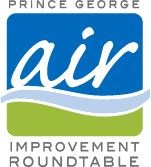The city's residents are being urged to "own their airshed" and take steps of their own to improve the quality of Prince George's air in the wake of a report that says emissions from industrial sources have improved significantly.
According to an update Prince George Air Improvement Roundtable issued Thursday, emissions from so-called "permitted emitters" have declined 40 per cent in the five years since a plan to reduce the amount of fine particulate going into the air was put into play in 2011.
"We can no longer just point at industry and say 'when they stop polluting, we will too,'" PGAIR manager Kim Menounos said in an inventory. "We all need to stop idling our vehicles, heating with wet wood."
The reduction from industrial sources has been credited to technological upgrades, financed partly through the federal government's $1-billion pulp and paper green transformation program, introduced in 2009 to counter "black liquor" subsidy to pulp mills in the United States.
Because they were outfitted with monitoring equipment, officials were able to measure the amount of particulate coming from those sources.
Not so clear have been emissions from other non-permitted industrial and commercial ventures like restaurants, fabricators, commercial heating, autobody shops, building construction, gravel pits and farm operations.
To that end, PGAIR is seeking funding to pay for an emissions inventory, similar to one launched in 2006. The highly-technical process begins with consultants taking air samples for a period of time and then conducting chemical analysis to determine their sources.
Wildfires posed a major problem last summer and the trouble could continue, according to the report, as climate change takes a stronger grip.
"The result is that air quality targets may be difficult to meet, and should therefore incorporate allowances for exceedances due to weather, wildfire or any other external sources beyond our management control," the report says.
PGAIR will continue to do outreach and education on ways residents can reduce their impacts.
"We've had a lot of wood stove change outs through the wood stove exchange program but people still continue to burn wood in the Bowl area and we still need to do lots of education on the proper use of wood, how to store and dry wood so that there is no moisture and it's not producing smoke," Menounos commented.
A public meeting to discuss the report's findings and where efforts should be targeted in the future will be held on Monday, June 4 at the Civic Centre, 7 p.m. start. Also, on June 4 and 5, experts from across the province will be meeting at the same venue to discuss ways to improve air quality in small and mid-size communities.
The full report is posted with this story at pgcitizen.ca.



